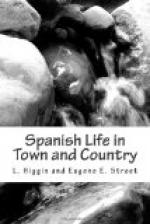Next to Gayangos in the same class of work, Marcelino Menendez y Palayo may perhaps be mentioned. His History of AEsthetic Ideas in Spain has been left unfinished so far, owing to the demands made on his time by his position in the political world as one of the Conservative leaders. Don Modesto Lafuente, though scarcely possessing the qualities of a great historian, is accurate and painstaking to a great degree; but in the field of history many workers are searching the archives and documents in which the country is so rich, and throwing light on particular periods. Canovas del Castillo, in spite of his great political duties, was one of the most valuable of these; and the eminent jurist, Don Francisco de Cardenas, and the learned Jesuit, Fidel Fita, and other members of the Academy of History are constantly working in the rich mine at Simancas. New papers and books are continually being brought out under the auspices of this society, throwing light on the past history of the country.
Fernan Caballero, a German by race, but married successively to three Spanish husbands, may be said to have inaugurated the modern Spanish novel de costumbres, and her books are perhaps better known in England than those of some of the later novelists. By far the greater writer of the day in Spain, however, in light literature, is Juan Valera, at once poet, critic, essayist, and novelist. His Pepita Jimenez is a remarkable novel, full of delicate characterisation and exquisite style, second to none produced in any country—a novel full of fire, and yet irreproachable in taste, handling a difficult subject with the mastery of genius. It has been translated into English; but however well it may have been done, it must lose immensely in the transition, because the Spanish of Valera is the perfection of a perfectly beautiful language. In this novel we have the character of a priest, who, while we know him only through the letters addressed to him by the young student of theology, the extremely sympathetic hero of the story, lives in one’s memory, showing us the best side of the Spanish priest. Other novels of Valera’s, Dona Luis and El Comendador Mendoza, a number of essays on all sorts of subjects, critical and other, and poems which show great grace and correctness of style, have given this writer a high place in the literature of the age.
Perez Galdos is a writer of a wholly different class, although he enjoys a very wide reputation in his own country and wherever Spanish is read. His Episodes Nacionales, some fifty-six in number, attract by their close attention to detail, which gives an air of actuality to the most diffuse of his stories. They are careful and very accurate studies of different episodes of national life, in which the author introduces, among the fictitious characters round whom the story moves, the real actors on the stage of history of the time. Thus Mendizabal, Espartero, Serrano,




